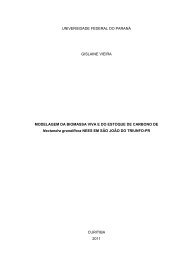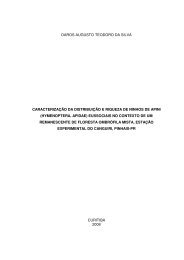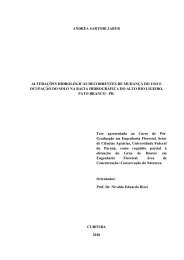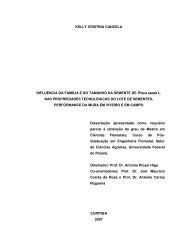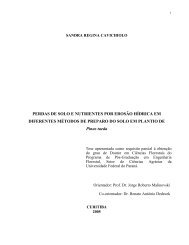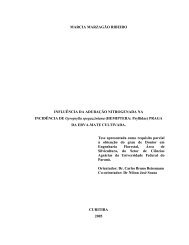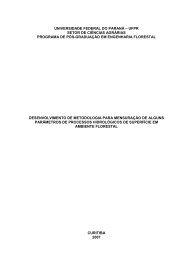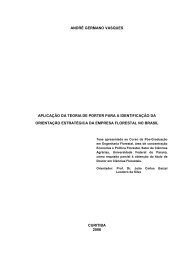Tese em PDF - departamento de engenharia florestal - ufpr ...
Tese em PDF - departamento de engenharia florestal - ufpr ...
Tese em PDF - departamento de engenharia florestal - ufpr ...
You also want an ePaper? Increase the reach of your titles
YUMPU automatically turns print PDFs into web optimized ePapers that Google loves.
na faixa granulométrica relativa a agregados miúdos (4,8 mm). Os corpos-<strong>de</strong>-prova<br />
foram ensaiados à compressão com 7 dias <strong>de</strong> ida<strong>de</strong>, resultando numa RC 7d média <strong>de</strong><br />
20,56 MPa, <strong>de</strong>svio padrão <strong>de</strong> 1,76 MPa e coeficiente <strong>de</strong> variação <strong>de</strong> 8,58%. Com esses<br />
valores, <strong>de</strong>terminou-se que a amostra mínima po<strong>de</strong>ria ser <strong>de</strong> até 3,0 CP, porém adotou-<br />
se, um valor mínimo <strong>de</strong> 4,0 CP.<br />
Na Tabela 4.9 apresentam-se as características físicas dos compósitos<br />
produzidos com o resíduo <strong>de</strong> Pinus spp, com granulometrias <strong>de</strong> Dmáx = 2,4 mm e 4,8<br />
mm. A apresentação procura comparar as características <strong>de</strong> cada compósito, <strong>em</strong><br />
função do teor <strong>de</strong> CaCl2.2H2O utilizado.<br />
TABELA 4.9 - INFLUÊNCIA DO TEOR DE CACL2.2H2O EM COMPÓSITOS COM RESÍDUO DE PINUS spp COM<br />
DMÁX = 2,4 mm E 4,8 mm – CARACTERÍSTICAS FÍSICAS DO COMPÓSITO<br />
D Máx Partícula (mm) e Massa Específica CV Índice <strong>de</strong> Vazios CV Absorção CV<br />
Teor <strong>de</strong> CaCl2 (%) ( kg/m (%) (%) (%) (%)<br />
(%)<br />
B<br />
0,45<br />
A<br />
1,15<br />
A<br />
3 )<br />
Mad 2,4 mm + 0,0% CaCl2 1.437,53<br />
38,56 26,82 1,36<br />
Mad 4,8 mm + 0,0% CaCl 2<br />
Mad 2,4 mm + 2,0% CaCl 2<br />
Mad 4,8 mm + 2,0% C<br />
aCl 2<br />
Mad<br />
2,4 mm + 4,0% CaCl2 Mad 4,8 mm + 4,0% CaCl 2<br />
Mad<br />
2,4 mm + 6,0% CaCl2 Mad 4,8 mm + 6,0% CaCl 2<br />
Mad 2,4 mm + 8,0% CaCl 2<br />
Mad 4,8 mm + 8,0% CaCl2 A A A<br />
1.471,10<br />
0,62 38,98 0,74 26,50 0,79<br />
B A A<br />
1.488,17<br />
1,09 35,57 3,47 23,91 2,86<br />
A B B<br />
1.526,92<br />
0,85 30,92 1,08 20,25 1,10<br />
B A A<br />
1.491,19<br />
0,68<br />
38,38 0,94 25,74<br />
A B<br />
B<br />
1.538,13<br />
0,52 35,62 0,99<br />
23,16 1,46<br />
A A A<br />
1.560,68<br />
1,00 34,88 2,24 22,35 1,60<br />
B A A<br />
1.526,65<br />
0,64 34,38 1,43 22,52 1,80<br />
A B B<br />
1.564,15<br />
0,16 35,76 3,23 22,86<br />
B A A<br />
1.479,38<br />
1,23 41,86 2,11 28,31<br />
Letras diferentes <strong>de</strong>notam diferenças estatísticas entre as médias nas colunas ao nível <strong>de</strong> 95% <strong>de</strong> confiança; Médias obtidas <strong>de</strong> 4 repetições;<br />
CV = Coeficiente <strong>de</strong> Variação; CaCl 2 = Aditivo acelerador <strong>de</strong> pega (Cloreto <strong>de</strong> Cálcio Bi-Hidratado)<br />
Analisando os valores apresentados, verifica-se:<br />
• As massas específicas dos compósitos produzidos com granulometrias<br />
confiança, para todos os teores <strong>de</strong> CaCl2.2H2O utilizados;<br />
1,49<br />
3,25<br />
3,30<br />
129<br />
diferentes, apresentam diferenças estatisticamente significativas a 95% <strong>de</strong><br />
• Quanto ao índice <strong>de</strong> vazios (porosida<strong>de</strong>) e absorção <strong>de</strong> água, não <strong>de</strong><br />
verificaram diferenças significativas entre os compósitos produzidos s<strong>em</strong>




